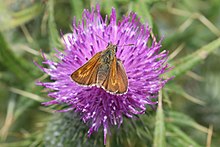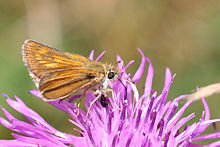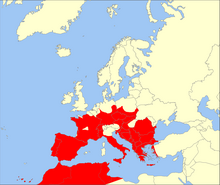| Lulworth skipper | |
|---|---|

| |

| |
| Both females Lulworth Cove, Dorset | |
| Scientific classification | |
| Domain: | Eukaryota |
| Kingdom: | Animalia |
| Phylum: | Arthropoda |
| Class: | Insecta |
| Order: | Lepidoptera |
| Family: | Hesperiidae |
| Genus: | Thymelicus |
| Species: | T. acteon
|
| Binomial name | |
| Thymelicus acteon (Rottemburg, 1775)
| |

| |
| Occurs locally in Central & Northern Europe, Asia Minor and North Africa | |
The Lulworth skipper (Thymelicus acteon) is a butterfly of the family Hesperiidae. Its name is derived from Lulworth Cove in the county of Dorset, England, where the first specimens in Great Britain were collected in 1832 by English naturalist James Charles Dale.
The species occurs locally across Central Europe, Asia Minor and North Africa, where its population is considered stable. Its numbers have declined in Northern Europe, leading to its European status of "vulnerable".[1] Its range in Britain is restricted to the south coast of Dorset, however it is locally abundant and its numbers currently are perhaps at their greatest since its discovery there.[2]
With a wingspan of 24 to 28 millimetres, females being larger than males, the Lulworth skipper is a small butterfly, the smallest member of the genus Thymelicus in Europe and among the smallest butterflies in Britain. Aside from the size difference, the sexes are distinguished by females having a distinct circle of golden marks on each forewing. Due to their likeness to the rays around the eye of a peacock's feather, these are often known as "sun-ray" markings, and they can faintly appear on males.
- ^ "Lulworth Skipper". Butterfly Conservation. Retrieved 1 July 2009.
- ^ Cite error: The named reference
BandI1991was invoked but never defined (see the help page).
